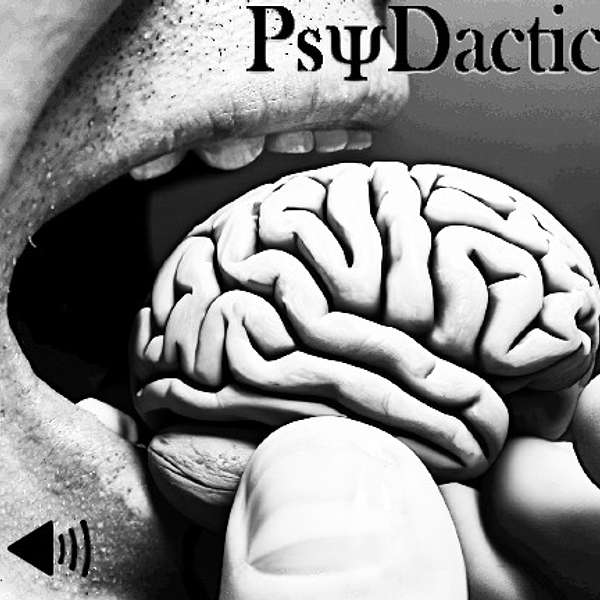
PsyDactic
A resource for psychiatrists and other medical or behavioral health professionals interested in exploring the neuroscientific basis of psychiatric disorders, psychopharmacology, neuromodulation, and other psychiatric interventions, as well as discussions of pseudoscience, Bayesian reasoning, ethics, the history of psychiatry, and human psychology in general.
This podcast is not medical advice. It strives to be science communication. Dr. O'Leary is a skeptical thinker who often questions what we think we know. He hopes to open more conversations about what we don't know we don't know.
Find transcripts with show-notes and references on each episodes dedicated page at psydactic.buzzsprout.com.
You can leave feedback at https://www.psydactic.com.
The visual companions, when available, can be found at https://youtube.com/@PsyDactic.
PsyDactic
A brief history of Electroconvulsive Therapy
A brief and exciting history of electroconvulsive therapy. You will learn how a method for anesthetizing pigs before slaughter was first used on a homeless and psychotic man and how it soon became the gold standard treatment for severe mood disorders.
Please leave feedback at https://www.psydactic.com or send any comments to feedback@psydactic.com.
References and readings (when available) are posted at the end of each episode transcript, located at psydactic.buzzsprout.com. All opinions expressed in this podcast are exclusively those of the person speaking and should not be confused with the opinions of anyone else. We reserve the right to be wrong. Nothing in this podcast should be treated as individual medical advice.
Welcome to PsyDactic - Residency Edition - Your podcast resource to survive and thrive in your psych residency.
I am Dr. O’Leary, and as of this recording I am a 2nd Year Resident in the National Capital Consortium Psychiatry Residency Program. However, make no mistake, I do not speak for this program, nor do I speak for the Department of Defense or the Federal Government or anyone else for that matter. What I say is my opinion, and I reserve the right to be wrong, so trust me at your own risk. It’s a risk some are willing to take.
In addition, I often use colorful language, in some cases to try to capture the zeitgeist of the period of which I’m speaking, and in others to try to keep you from falling asleep. Some of this language may seem insensitive, but it is not my intent to offend, dismiss, or belittle anyone.
In today’s episode, I am going to necessarily oversimplify how a technology that had independently been innovated for anesthetizing pigs before slaughter made its way into psychiatric practice. I am speaking of electro-convulsive therapy or ECT for short. I love the dirty-rotten details of history, so this episode is dedicated to the first pioneers who actually conceived of strapping patients to a bed and shocking their heads. These innovators were not the first or the last neuropsychiatrists to attempt to treat the mind by assaulting the body. Long before there was neuroscience, ancient physicians might apply electric stingrays to the head to relieve headaches, or use electric eels to cast out demons. Fast forward centuries to the early 1920s when the world was still postictal from The Great War and heading rapidly toward another global convulsion.
Before there was electro-convulsive therapy (also known as electro-shock therapy), there was chemical convulsive therapy, and before there was chemo-convulsive therapy, there were a number of somatic therapies including bizarre sounding ones like the Scotch Douche therapy, where jets of hot or cold water were directed at patients, similar to other hydrotherapies that naturopaths might prescribe to rid the body of “impurities” or activate the hidden healing powers of the autonomic nervous system. There were more sinister sounding therapies like pyrotherapy, where high fevers were induced, often by causing malaria after injecting patients with the Plasmodium parasite. As odd as it sounds, pyrotherapy was found to be rather effective at treating a once common cause of psychosis: neurosyphilis. You may also have heard of insulin coma therapy, where physicians induced a coma in patients by giving large doses of insulin and dropping their blood sugar to sometimes fatal levels. Interestingly, many of these patients also seized, which at the time was considered an unwanted side effect. There were also more benign sounding therapies like prolonged sleep therapy, which, despite its cozy name, resulted in dozens of patient deaths after spending days to months chemically sedated in hopes that this artificial sleep would alleviate the anxieties that had taken control of their mind. (https://www.sciencefriday.com/articles/from-fever-cure-to-coma-therapy-psychiatric-treatments-through-time/)
Most previous somatic therapies have fallen out of medical practice and are either relics of history or relegated to vitalist approaches like naturopathy. However, convulsive therapies remain in the form of ECT. The first convulsive therapies were achieved by injecting chemicals into patients. “Why was this ever attempted?” you might ask. Like so many other quirks of history it may have been in part due to an insidious rumor (in the form of faulty epidemiological studies) that patients with epilepsy tend to have less psychotic illness than those without. In fact, patients with epilepsy are more prone to psychotic illness.
In 1934, Dr. Ladislas Joseph von Meduna from Hungary hypothesized that inducing seizures into catatonic patients by injecting them intramuscularly with camphor oil would improve them, and it seemed to work. Meduna wasn’t simply chasing an epidemiological rumor. He had extensively studied the dissected brains of patients with dementia praecox (now labeled schizophrenia) as well as those with epilepsy, and had noticed that glial cells in the brains of the chronically psychotic were reduced, while those in patients with epilepsy were relatively increased. Perhaps, Meduna hypothesized, seizures caused a proliferation of glial cells which are protective against psychosis.
Chemically inducing seizures was not without its problems. Camphor was unpleasant to have injected and also was not very reliable at inducing seizures. Later, Meduna moved from camphor to IV pentylenetetrazol (Cardiazol or Metrozol as branded). However, due to the unfortunate side effects of Metrozol’s sympathetic activation, patients were frequently terrified by their chemically-induced panic, which did not encourage them to try again.
The first ECT machine was developed near where the ancient god Jupiter sits in timeless glory, staring out at humanity with empty granite eyes, in Rome, by Drs. Ugo Cerletti and Lucio Bini. If you think that duo sound like the founders of a bourgie pasta company, I think you’ll find their noodles rather shocking. At a 1937 meeting in Switzerland, they first reported promising results electrifying dogs, a favored model of physiologists at the time. When first applying electrical shocks to their canine subjects, initially electrodes were placed in the mouth and the anus. Half the animals died unceremoniously of cardiac dysrhythmias, which at first made the therapy seem unattractive for human testing. But other therapies, like insulin comas and deep sleep therapy, were also killing patients, so it wasn’t a complete deal killer. Bini, with an ample supply of stray dogs from the local dog-catcher, later found that placing electrodes on the bilateral temples reliably produced non-fatal seizures.
This combined with observations that pigs at the local slaughterhouse who were shocked in a similar manner to induce anesthesia before having their throats slit would after a few minutes return to consciousness gave Cerletti and Bini the confidence to try it out on people. It was a stray human, caught wandering and speaking unintelligibly at the local train station who became the first homo sapiens test of ECT. He could not communicate who he was or where he lived. He developed a notable indifference to his surroundings in a state suggestive of catatonia. This first documented attempt at human ECT took three tries, each with increasing voltage. After the first two attempts, the patient awoke quickly, to the relief of the physicians who, I assume, were hoping that they would not kill him, but also proving that no seizure had occurred. After the third attempt, the patient became tonic and then entered the clonic phase of an epileptic seizure. The procedure had worked. After a total of 11 treatments, S.E. was discharged home, having regained enough faculties to remember who he was and reportedly to begin working again, though he was far from completely cured.
ECT rapidly spread across the globe, despite WWII. In fact, the migration of doctors fleeing from tyrannical regimes in Europe may have encouraged this spread. As the practice spread, the potential side effects from causing seizures could not be ignored, especially how sustained muscle contracts could tear flesh and break bones. The addition of paralytics and anesthesia brought that chapter to a close, and it appeared ECT would continue to become safer and more tolerable for patients. While catatonic psychosis was the first condition ECT demonstrated effectiveness in, it was subsequently found to be the most effective treatment to date for unipolar depression and mania.
Psychiatrists with a new toy were eager to try it out on any number of hard cases, including patients colloquially called psychopaths, bed-wetters, and addicts. The initial excitement resulting in the overly broad application of ECT garnered the criticism of more deliberate psychiatrists as well as the public. ECT was featured in the hit film One Flew Over the Cuckoo Nest in 1975 based on the 1962 novel by the same name which had inspired a Broadway production in 1963 that later went off broadway. Now, the image of ECT as a punishment for bad behavior is struck indelibly onto the consciousness of multiple generations. Even the current popular YouTube Channel SciShow describes ECT as a dangerous treatment only used as a last resort.
Around the the same time that ECT was losing support despite gaining evidence of efficacy, other effective treatments for psychotic symptoms and depression were developed, including the first antipsychotic chlorpromazine, marketed as Thorazine, and the first tricyclic antidepressant, imipramine, an antihistaminic drug whose antidepressant properties were, like convulsive therapies, first discovered while attempting to treat psychosis. Lithium was found to treat mania, though relatively slowly, and provide effective maintenance therapy as well. Benzodiazepines were effective for a large percentage of catatonic patients, becoming the default first line treatment. A slew of other drugs subsequently gave clinicians many choices to turn too if their first, second, or even third attempt at pharmaco-therapy failed. And yet, ECT is still often referred to as the most effective, most powerful, most under-utilized and under-available therapy is psychiatry today.
**musical break**
Will ECT make it out of the shadows? Why do we still practice it today? Is it just an elaborate placebo? Will other therapies like TMS edge ECT out of the market? These and more questions will be answered with varying levels of competence in future episodes of PsyDactic - Residency Edition.
References 1–4
2. Endler NS. The origins of electroconvulsive therapy (ECT). Convuls Ther. 1988;4(1):5-23.
Podcasts we love
Check out these other fine podcasts recommended by us, not an algorithm.

Mindhunting: Journeys in Forensic Psychiatry
Dr Michael Schirripa
Brain Science with Ginger Campbell, MD: Neuroscience for Everyone
Ginger Campbell, MD
